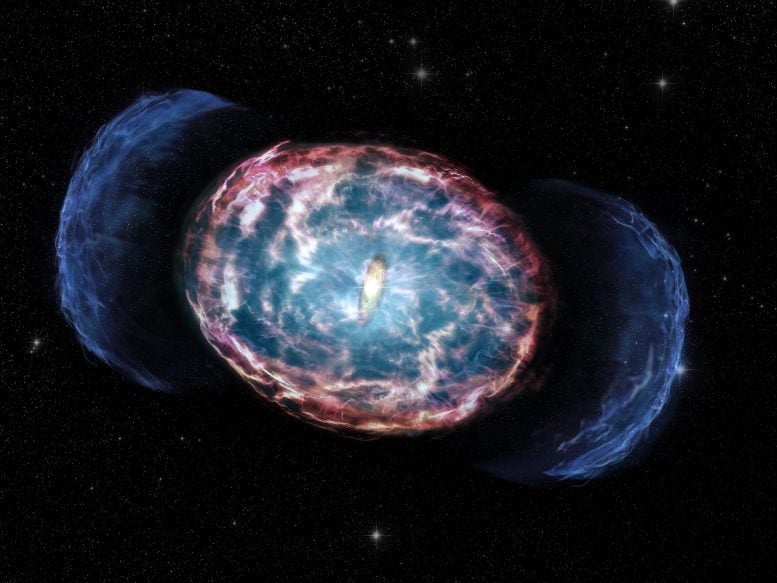Astronomers May Have Detected a “Sonic Boom” From a Powerful Blast Known as a Kilonova

NASA’s Chandra X-ray Observatory has been collecting data on a kilonova—a powerful event illustrated here that happens when two neutron stars merge—associated with GW170817. This is the first cosmic event that has produced gravitational waves and electromagnetic radiation, or light, that have been detected on Earth. Credit: X-ray data from NASA, CXC and Northwestern Univ./A. Hajela; visual by NASA/CXC/M. Weiss
Astronomers may have detected a “sonic boom” from a powerful blast known as a kilonova. This event—called GW170817—is a result of a merger of two neutron stars and is the first object for which both
Astronomers think that after neutron stars merge, the debris generates light in the visible and infrared spectrum from the decay of radioactive elements like platinum and gold formed in the debris from the merger. This burst of light is called a kilonova. In the case of GW170817, visible light and infrared emission were detected several hours after the gravitational waves.
The neutron star merger looked very different in X-rays. Right after the initial LIGO detection was announced, scientists requested that Chandra quickly pivot from its current target to GW170817. At first, they did not see any X-rays from the source, but on Aug. 26, 2017, Chandra looked again and found a point source of X-rays.
This non-detection of X-rays quickly followed by a detection provides evidence for a narrow jet of high-energy particles produced by the neutron star merger. The jet is “off-axis” – that is, not pointing directly towards Earth. Researchers think that Chandra originally viewed the narrow jet from its side, and therefore saw no X-rays immediately after the gravitational waves were detected.
However, as time passed, the material in the jet slowed down and widened as it slammed into surrounding material. This caused the cone of the jet to begin to expand more into Chandra’s direct line of sight, and X-ray emission was detected.
Since early 2018, the X-ray emission caused by the jet had steadily been getting fainter as the jet further slowed down and expanded. The research team then noticed that from March 2020 until the end of 2020 the decline stopped and the X-ray emission was approximately constant in brightness. This was a significant sign.
“The fact that the X-rays stopped fading quickly was our best evidence yet that something in addition to a jet is being detected in X-rays in this source,” said co-author Raffaella Margutti of the University of California at Berkeley. “A completely different source of X-rays appears to be needed to explain what we’re seeing.”
A leading explanation for this new source of X-rays is that the expanding debris from the merger has generated a shock, like the sonic boom from a supersonic plane. The emission produced by material heated by the shock is called a kilonova afterglow. An alternative explanation is that the X-rays come from material falling toward a black hole that formed after the neutron stars merged. GW170817 would be the first observation of either explanation.
“Further study of GW170817 could have far-reaching implications,” said co-author Kate Alexander, also from Northwestern University. “The detection of a kilonova afterglow would imply that the merger did not immediately produce a black hole. Alternatively, this object may offer astronomers a chance to study how matter falls onto a black hole a few years after its birth.”
To distinguish between the two explanations, astronomers will keep monitoring GW170817 in X-rays and radio waves. If it is a kilonova afterglow, the radio emission is expected to get brighter over time and be detected again in the next few months or years. If the explanation involves matter falling onto a newly formed black hole, then the X-ray output should stay steady or decline rapidly, and no radio emission will be detected over time. New Chandra observations of GW170817 from December 2021, which the team is currently analyzing, could help resolve this question.
“This observation also paves the way for further study,” said co-author Ashley Villar, assistant professor of astronomy and astrophysics at Penn State. “When LIGO begins its fourth observing run, we hope to find more kilonovae and really explore the diversity of these events, including how the mass and energy signatures differ in the afterglow and how nonthermal components like jet structure might vary. The richness of this dataset is essential in illuminating the physics driving this diversity.”
For more information on this research see:
Reference: “The emergence of a new source of X-rays from the binary neutron star merger GW170817” by A. Hajela, R. Margutti, J. S. Bright, K. D. Alexander, B. D. Metzger, V. Nedora, A. Kathirgamaraju, B. Margalit, D. Radice, E….
Read More: Astronomers May Have Detected a “Sonic Boom” From a Powerful Blast Known as a Kilonova

